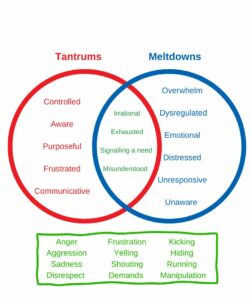Tantrum or Meltdown?
When children become dysregulated, it can frequently be seen that they are referred to as having a ‘tantrum’. On face value, tantrums and meltdowns can often look similar, but their role is different.

A tantrum
A tantrum is usually associated with wanting something. It will normally come to an end once the child has what they wanted. Children have some control over their tantrums. Some children will stop their tantrum momentarily to check if they are receiving the desired attention and restart once they have confirmation of this. It will come to an end when their goal is reached, or they are offered something of higher value. Whether this is being given something that they want, seeking a change of behaviour or receiving a different response from a parent. It may be that the parent has ‘given in’. It should be noted, that some children will use tantrums to seek attention from parents, distract them away from someone else, such as a sibling or another parent.
A meltdown
A meltdown is associated with overwhelm. Where a child becomes overwhelmed with sensory triggers and there is too much for them to process and understand. This can be environmental, such as being at a party and having too much noise, lights, colours and people. Where everything happens all at once, children cannot process it at the speed it is happening. This can also be related to events we may expect children to love, such as birthdays, Christmas, holidays and festivities. For other children, it can be having too much pressure all at once, or too much to take in such as a new school, teachers, things to learn or even new clothes or toys. A child does NOT want a meltdown and they last long after the trigger has left. A meltdown will often end once a child is exhausted or finds a space which removes the overwhelm and sensory input.
Want to learn more?
If you want to learn more about mental health, you can join our Level 4 training (here) or keep an eye out for our new courses coming soon (here).
© Dandelion Training and Development – All Rights Reserved
Further help
For more articles about mental health visit – ARTICLES
To learn more about child and adolescent mental health visit – COURSES
For resources to support child and adolescent mental health visit –RESOURCES

